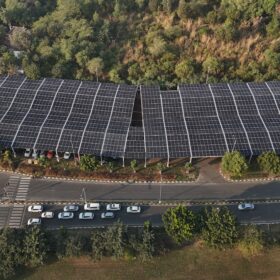In an age where the imperatives of sustainability and climate action dominate global discourse, innovative approaches at the intersection of energy and agriculture have garnered increasing attention. Among these, agrivoltaics, a practice of combining PV installations with agricultural activities, presents a unique opportunity to address pressing challenges in land use, climate resilience, and energy transition. Recognizing its transformative potential and how it cuts across many other areas of research, the International Energy Agency Photovoltaic Power Systems Programme (IEA PVPS) has established the Action Group on Agrivoltaics, an innovative format within the programme.
1. Advantages and Challenges of Agrivoltaics
The global surge in population has led to an increased demand for food, amplifying the pressure on available land for both agricultural and energy purposes. Concurrently, challenges such as water scarcity, extreme weather events, and rising temperatures due to the climate crisis have intensified, posing significant obstacles to agricultural practices. Farmers find themselves grappling with regulatory constraints and economic uncertainty, hampering their ability to safeguard water resources, protect wildlife, and maintain crop yields.
Agrivoltaics, the practice of co-locating solar panels with agricultural activities, presents a promising solution to these challenges. By maximizing land productivity through the combined use of land, and addressing concerns of land scarcity, agrivoltaics offer tangible benefits. Additionally, it enhances agricultural resilience by providing shade, reducing water evaporation, and mitigating the impact of climate change on crop yields. Consequently, agrivoltaics attracted significant interest from policymakers, researchers, and stakeholders worldwide.
Despite its clear advantages, agrivoltaics encounter barriers to widespread implementation. Legal obstacles impede the approval process for construction, and its often higher costs can hinder progress if there are not adequate incentives available. Moreover, varying levels of public support across regions necessitate concerted efforts to engage stakeholders and garner community backing for proposed projects.
2. Objectives and Outcomes of the new Action Group
The primary objectives of the Action Group are to assess the current state of agrivoltaics knowledge as well as provide a forum to foster international collaboration. By synthesizing existing research, fostering interdisciplinary and international dialogue, and producing comprehensive reports, the group aims to achieve three primary outcomes: optimizing land use efficiency, enhancing agricultural resilience, and fostering social consensus for solar energy adoption. The forthcoming public report, “Status Quo and Global Trends in Agrivoltaics,” scheduled for release in November 2025, will serve as a cornerstone in this endeavor, accompanied by internal recommendations to guide future IEA PVPS actions in the agrivoltaics domain.
3. Collaborative Endeavors: Approaches and Guiding Principles
Rather than conducting new research, the Action Group focuses on consolidating existing knowledge and fostering collaboration across IEA PVPS Tasks. Reflecting how agrivoltaics are a multi-disciplinary field, IEA PVPS Tasks are already working on this topic, such as Task 12 (PV Sustainablity Activities, Task 13 (Reliability and Performance of Photovoltaic Systems), and to some extent also Task 16 (Solar Resource for High Penetration and Large Scale Applications). Task 12 and Task 13 will deliver and publish reports on Agrivoltaics in 2024. The new Action Group aims to coordinate efforts and enhance synergies across different initiatives. Through literature reviews, virtual exchanges, thematic workshops, and summary reports, the group aims to bridge disciplinary boundaries and foster a vibrant agrivoltaics community within IEA PVPS. By harmonizing methodologies and defining common metrics, the group seeks to lay the groundwork for future research endeavors and international collaborative initiatives.
4. Phases of Action
The Action Group embarks on a journey spanning three distinct phases: formation, stakeholder engagement, and synthesis. During the formation phase, the group lays the groundwork, establishing key advisory and working teams, clarifying roles, and defining objectives. The subsequent stakeholder workshops serve as catalysts for engagement, fostering dialogue, and knowledge exchange. Finally, the synthesis phase culminates in the development of a comprehensive report, encapsulating the collective insights and recommendations of the Action Group.
Conclusion
As the global community strives for sustainable energy solutions, agrivoltaics emerge as a promising avenue for progress. The IEA PVPS Action Group on Agrivoltaics plays a pivotal role in advancing this agenda, fostering collaboration, and shaping the future of sustainable energy and agriculture. Through its cooperative endeavors, the group paves the way for a brighter, more sustainable future for generations to come.
The Agrivoltaics Action Group is co-led by Alessandra Scognamiglio (ENEA, Italy) and Jordan Macknick (NREL, USA). They encourage interested parties willing to collaborate and participate in the Action Group to contact them at: alessandra.scognamiglio@enea.it and jordan.macknick@nrel.gov.
Author: Bettina Sauer
The views and opinions expressed in this article are the author’s own, and do not necessarily reflect those held by pv magazine.
This content is protected by copyright and may not be reused. If you want to cooperate with us and would like to reuse some of our content, please contact: editors@pv-magazine.com.








By submitting this form you agree to pv magazine using your data for the purposes of publishing your comment.
Your personal data will only be disclosed or otherwise transmitted to third parties for the purposes of spam filtering or if this is necessary for technical maintenance of the website. Any other transfer to third parties will not take place unless this is justified on the basis of applicable data protection regulations or if pv magazine is legally obliged to do so.
You may revoke this consent at any time with effect for the future, in which case your personal data will be deleted immediately. Otherwise, your data will be deleted if pv magazine has processed your request or the purpose of data storage is fulfilled.
Further information on data privacy can be found in our Data Protection Policy.